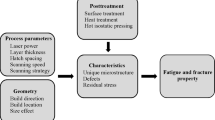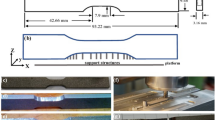Abstract
Selective laser melting (SLM) of titanium components is gradually gaining popularity in various fields, such as aerospace, automobile, and medical for the purpose of saving material and reducing the carbon footprint. To capitalize on their benefits, the mechanical properties of parts fabricated by SLM must meet engineering requirements. Fatigue properties are particularly important for the performance of safety-critical structures. In this research, rolling contact fatigue (RCF) tests were performed for SLM fabricated Ti–6Al–4V samples in differently post-treated conditions to investigate the effect of different post-processing methods on the fatigue properties and, as a comparison, forgings of Ti–6Al–4V were also tested. It was found that the RCF properties of the Ti–6Al–4V generated by SLM were superior to those of the forged specimens and strengthened after polishing and heat treatment. The worn surfaces were observed by using an optical microscope, and the results indicated that surface and subsurface defects are the main causes of fatigue crack initiation and the residual stresses enhance fatigue crack growth.
Similar content being viewed by others
References
Thomas D (2009) The development of design rules for selective laser melting. University of Wales
Vilaro T, Colin C, Bartout JD (2011) As-fabricated and heat-treated microstructures of the Ti-6Al-4V alloy processed by selective laser melting. Metall Mater Trans A 42(10):3190–3199. https://doi.org/10.1007/s11661-011-0731-y
Vrancken B, Thijs L, Kruth J-P, Van Humbeeck J (2012) Heat treatment of Ti6Al4V produced by selective laser melting: microstructure and mechanical properties. J Alloys Compd 541:177–185. https://doi.org/10.1016/j.jallcom.2012.07.022
Shunmugavel M, Polishetty A, Littlefair G (2015) Microstructure and mechanical properties of wrought and additive manufactured Ti-6Al-4V cylindrical bars. Procedia Technol 20:231–236. https://doi.org/10.1016/j.protcy.2015.07.037
Qiu C, Adkins NJE, Attallah MM (2013) Microstructure and tensile properties of selectively laser-melted and of HIPed laser-melted Ti–6Al–4V. Mater Sci Eng A 578:230–239. https://doi.org/10.1016/j.msea.2013.04.099
Suryawanshi J, Prashanth KG, Ramamurty U (2017) Mechanical behavior of selective laser melted 316L stainless steel. Mater Sci Eng A 696:113–121. https://doi.org/10.1016/j.msea.2017.04.058
Casati R, Lemke J, Vedani M (2017) Microstructural and mechanical properties of as built, solution treated and aged 18 Ni (300 grade) maraging steel produced by selective laser melting. Additive Manufacturing
Boschetto A, Bottini L, Veniali F (2017) Roughness modeling of AlSi10Mg parts fabricated by selective laser melting. J Mater Process Technol 241:154–163. https://doi.org/10.1016/j.jmatprotec.2016.11.013
Leary M, Mazur M, Elambasseril J, McMillan M, Chirent T, Sun Y, Qian M, Easton M, Brandt M (2016) Selective laser melting (SLM) of AlSi12Mg lattice structures. Mater Des 98:344–357. https://doi.org/10.1016/j.matdes.2016.02.127
Mumtaz K, Hopkinson N (2009) Top surface and side roughness of Inconel 625 parts processed using selective laser melting. Rapid Prototyp J 15(2):96–103. https://doi.org/10.1108/13552540910943397
Boyer RR (1996) An overview on the use of titanium in the aerospace industry. Mater Sci Eng A 213(1-2):103–114. https://doi.org/10.1016/0921-5093(96)10233-1
Cain V, Thijs L, Van Humbeeck J, Van Hooreweder B, Knutsen R (2015) Crack propagation and fracture toughness of Ti6Al4V alloy produced by selective laser melting. Addit Manuf 5:68–76. https://doi.org/10.1016/j.addma.2014.12.006
Edwards P, Ramulu M (2014) Fatigue performance evaluation of selective laser melted Ti–6Al–4V. Mater Sci Eng A 598:327–337. https://doi.org/10.1016/j.msea.2014.01.041
Leuders S, Thöne M, Riemer A, Niendorf T, Tröster T, Richard HA, Maier HJ (2013) On the mechanical behaviour of titanium alloy TiAl6V4 manufactured by selective laser melting: fatigue resistance and crack growth performance. Int J Fatigue 48:300–307. https://doi.org/10.1016/j.ijfatigue.2012.11.011
Siddique S, Imran M, Rauer M, Kaloudis M, Wycisk E, Emmelmann C, Walther F (2015) Computed tomography for characterization of fatigue performance of selective laser melted parts. Mater Des 83:661–669. https://doi.org/10.1016/j.matdes.2015.06.063
Wycisk E, Emmelmann C, Siddique S, Walther F (2013) High cycle fatigue (HCF) performance of Ti-6Al-4V alloy processed by selective laser melting. Adv Mater Res 816-817:134–139. https://doi.org/10.4028/www.scientific.net/AMR.816-817.134
Greitemeier D, Dalle Donne C, Syassen F, Eufinger J, Melz T (2016) Effect of surface roughness on fatigue performance of additive manufactured Ti–6Al–4V. Mater Sci Technol 32(7):629–634. https://doi.org/10.1179/1743284715y.0000000053
Günther J, Krewerth D, Lippmann T, Leuders S, Tröster T, Weidner A, Biermann H, Niendorf T (2017) Fatigue life of additively manufactured Ti–6Al–4V in the very high cycle fatigue regime. Int J Fatigue 94:236–245. https://doi.org/10.1016/j.ijfatigue.2016.05.018
Mercelis P, Kruth J-P (2006) Residual stresses in selective laser sintering and selective laser melting. Rapid Prototyp J 12(5):254–265. https://doi.org/10.1108/13552540610707013
Sadeghi F, Jalalahmadi B, Slack TS, Raje N, Arakere NK (2009) A review of rolling contact fatigue. J Tribol 131(4):041403. https://doi.org/10.1115/1.3209132
Kruth JP, Froyen L, Van Vaerenbergh J, Mercelis P, Rombouts M, Lauwers B (2004) Selective laser melting of iron-based powder. J Mater Process Technol 149(1–3):616–622. https://doi.org/10.1016/j.jmatprotec.2003.11.051
Strano G, Hao L, Everson RM, Evans KE (2013) Surface roughness analysis, modelling and prediction in selective laser melting. J Mater Process Technol 213(4):589–597. https://doi.org/10.1016/j.jmatprotec.2012.11.011
Ben V, Jean-Pierre K (2007) Selective laser melting of biocompatible metals for rapid manufacturing of medical parts. Rapid Prototyp J 13(4):196–203. https://doi.org/10.1108/13552540710776142
Murr LE, Quinones SA, Gaytan SM, Lopez MI, Rodela A, Martinez EY, Hernandez DH, Martinez E, Medina F, Wicker RB (2009) Microstructure and mechanical behavior of Ti-6Al-4V produced by rapid-layer manufacturing, for biomedical applications. J Mech Behav Biomed Mater 2(1):20–32. https://doi.org/10.1016/j.jmbbm.2008.05.004
Bhushan B (2013) Adhesion. In: Introduction to Tribology. John Wiley & Sons, Ltd, pp 157–198. https://doi.org/10.1002/9781118403259.ch4
Bhushan B (2013) Wear. In: Introduction to Tribology. John Wiley & Sons, Ltd, pp 315–397. https://doi.org/10.1002/9781118403259.ch7
Wang Z, Xiao Z, Huang C, Wen L, Zhang W (2017) Influence of ultrasonic surface rolling on microstructure and wear behavior of selective laser melted Ti-6Al-4V alloy. Materials 10(10):1203. https://doi.org/10.3390/ma10101203
Funding
This work received financial support from the National High Technology Research and Development Program of China (863 Program: 2015AA042501).
Author information
Authors and Affiliations
Corresponding author
Rights and permissions
About this article
Cite this article
Zhang, P., Zhang, D.Z., Peng, D. et al. Rolling contact fatigue performance evaluation of Ti–6Al–4V parts processed by selective laser melting. Int J Adv Manuf Technol 96, 3533–3543 (2018). https://doi.org/10.1007/s00170-018-1576-y
Received:
Accepted:
Published:
Issue Date:
DOI: https://doi.org/10.1007/s00170-018-1576-y




